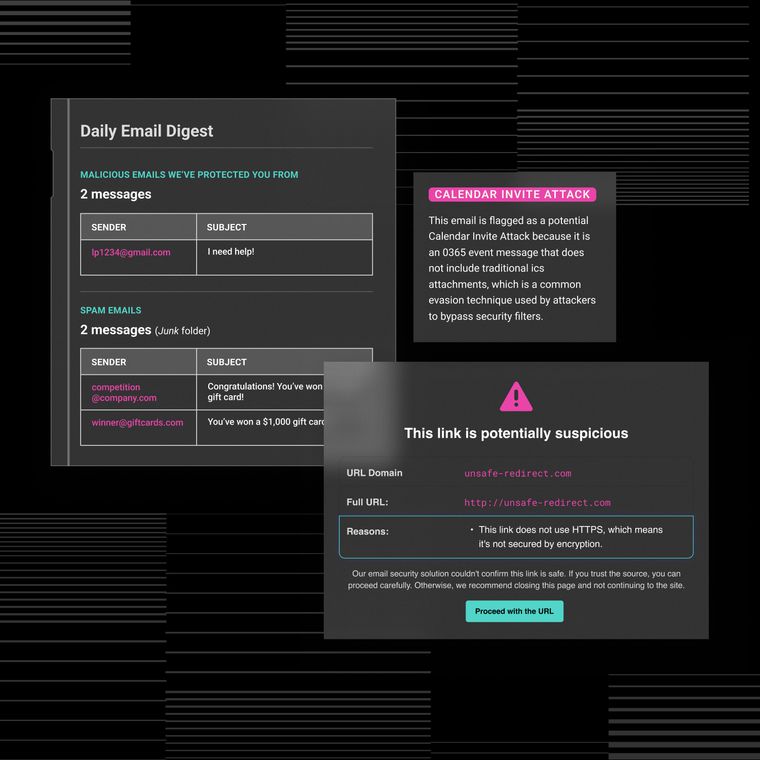Top 7 Cloud Attack Vectors and How to Defend Against Them
Discover the most common cloud attack vectors targeting your infrastructure and learn proven defense strategies to protect against misconfigurations, compromised credentials, and insider threats.
July 10, 2025
Cloud attacks are a top cyber risk concern, according to a report from PWC. Most of these breaches stem from preventable security gaps. Misconfigurations, compromised credentials, and insecure APIs provide attackers with easy entry points into cloud environments that expand faster than security controls can keep pace.
The seven most common cloud attack vectors below provide concrete defenses that integrate into existing security controls. Use these insights to close security gaps before adversaries exploit them.
1. Misconfigured Cloud Services
Misconfigured cloud resources remain the fastest path for attackers to establish initial access, whether through exposed storage buckets or overly permissive IAM roles.
Publicly accessible storage, default-open security groups, and forgotten test instances represent common misconfigurations that occur more frequently than most teams acknowledge. Attackers continuously scan for these vulnerabilities because a single error can expose entire datasets.
You can dramatically reduce this risk by deploying automated tools to detect configuration drift and remediate risky settings. Use infrastructure-as-code templates so every resource launches in a secure state. Enforce least-privilege access controls and rotate keys frequently while running continuous compliance scans to identify new gaps before attackers can exploit them.
Proactive posture management costs far less than incident response and keeps your cloud environment resilient as workloads scale.
2. Compromised Credentials and Account Takeover
Stolen or abused credentials open the door to your entire cloud estate, making account takeover the fastest route to lateral movement, data theft, and business email compromise (BEC).
Credential stuffing campaigns recycle leaked username-password pairs until one works, while phishing lures harvest fresh logins and session cookies for immediate use. Attackers then hijack active sessions, spin up rogue resources, or exfiltrate sensitive data, actions that drive the average breach cost.
Once inside, they rarely stop at a single workload. With valid keys in hand, they abuse API tokens, create backdoor IAM users, and reroute email flows to execute sophisticated BEC fraud, all before legacy controls notice anything amiss.
Protecting against account takeover requires layered identity defenses that start with eliminating password-only authentication. Deploy phishing-resistant MFA built on WebAuthn to block credential-based attacks at the source. Conditional access policies should weigh device health, geolocation, and risk signals before granting sessions, creating dynamic barriers that adapt to threat conditions.
Identity threat detection and response integration catches privilege escalations or token misuse in real-time, while session anomaly monitoring flags impossible travel, vendor logins at unusual hours, and sudden OAuth grants. These systems should automatically revoke suspect tokens before attackers can establish a persistent presence.
3. Insecure APIs and Interfaces
APIs sit at the core of every cloud workload, making a single insecure endpoint an immediate attack vector for data theft and service disruption.
You can rely on these interfaces to automate provisioning, integrate partners, and expose functionality to customers, yet each call widens the attack surface. This is because attackers exploit common issues, such as broken authorization, excessive data exposure, and mass assignment, to bypass traditional perimeter defenses.
You can mitigate risk through strategic access controls and validation layers by:
Deploying least-privilege tokens that only allow necessary methods and resources.
Using a strict schema validation to reject unexpected parameters, rate limiting to absorb brute-force attempts, and zero-trust segmentation to isolate API tiers from back-end data stores.
Embedding automated security testing into CI/CD pipelines to catch issues before production deployment.
Remember, treating API security as a first-class discipline, on par with code quality and uptime, keeps your services open for business, not for attackers.
4. Supply-Chain and Third-Party Integrations
Compromised supply chains and third-party integrations create direct pathways for attackers to infiltrate production cloud workloads. Every vendor relationship inherits its security posture, making a single poisoned update, abused OAuth token, or overly broad API permission capable of cascading across your entire environment.
Rigorous vendor risk assessments form your first line of defense. Here’s what you can follow:
Require every partner to document secure development practices, disclose vulnerabilities promptly, and meet the same controls you enforce internally.
Grant OAuth scopes according to least privilege; automation bots requiring only read access should never receive write permissions.
Monitor connected apps continuously using automated tooling that flags unusual API calls or configuration drifts in real-time.
Demand a Software Bill of Materials (SBOM) for every packaged artifact, verify digital signatures before deployment, and run runtime code-integrity checks that quarantine binaries when hashes change.
These layered controls close the trust gaps attackers exploit and prevent third-party innovation from becoming a security liability.
5. Insider Threats (Malicious and Accidental)
Insider threats come in two forms: malicious actions, such as privilege misuse or data theft, and accidental errors, including oversharing public links or misconfiguring sensitive storage.
Because insiders operate with valid credentials, their activity blends in naturally, making detection far harder than spotting external attackers. The challenge multiplies in cloud environments where permissions sprawl quickly and access extends to contractors, service accounts, and third-party applications.
Security awareness training helps, but it won't catch a rogue administrator siphoning data at midnight. You need behavior-driven controls that surface anomalies in real time. Here are some quick fixes to implement:
Begin with user behavior analytics to establish baselines for normal activity and promptly identify deviations.
Deploy data loss prevention tools that inspect files, chat logs, and email for sensitive content before it leaves your environment.
Apply zero-trust, least-privilege policies to minimize the access any single identity can have, and use just-in-time access so that elevated permissions expire automatically after tasks are completed.
Monitor each employee's typical patterns across email and collaboration platforms, alerting when seemingly legitimate sessions deviate from course, whether that involves mass-downloading source code or quietly creating public links.
These layered defenses turn insider behavior from a blind spot into a continuously monitored control point.
6. Malware and Ransomware via Cloud Storage and SaaS
Malware and ransomware now spread through cloud storage and SaaS platforms, hiding in collaborative drives and pivoting to cloud virtual machines for crypto-jacking attacks that drain budgets while obscuring visibility.
The 2025 IBM Threat Intelligence Index reveals that malware and ransomware are the primary motives behind 17 percent of attacker actions in North America, highlighting the frequency with which these payloads succeed in cloud environments.
Attackers place loaders inside shared drives, rely on synchronization to overwrite clean versions, then move to cloud workloads for persistent access. Once inside, modern strains disable version history, delete snapshots, and encrypt customer files, placing personal information and entire SaaS workspaces at risk. Most of the infections spread laterally across buckets and SaaS tenants within under an hour, rendering manual responses ineffective.
Here are some defense mechanisms to follow:
Combine layered controls with automation that contains outbreaks the moment a malicious hash appears through object-level malware scanning on every upload and download
Deploy immutable backups with routine restore tests to guarantee clean recovery, while runtime EDR agents on cloud workloads halt encryption processes
Use network segmentation to block east-west traffic between storage zones and compute nodes, and threat-intel-enriched detections to surface emerging ransomware families in SaaS logs
Automatic isolation of any bucket, share, or virtual machine flagged as infected prevents cascade effects across your environment. These measures turn cloud storage from an easy target into a contained, monitored environment where ransomware cannot spread unchecked.
7. Phishing and Business Email Compromise in Cloud Collaboration Apps
Phishing-driven account takeover thrives in cloud suites because attackers impersonate trusted colleagues inside Microsoft 365, Google Workspace, Slack, and Teams, quietly redirecting funds and data before detection.
Once an inbox or channel is breached, threat actors stay invisible by replying within existing threads, manipulating SharePoint links, or requesting wire transfers through spoofed approvals, tactics that slip past legacy email security solutions.
Modern attackers weaponize legitimate services, hijacked sessions, and look-alike domains that escape static rules. They abuse multi-channel workflows: a phishing link arrives in an email, the rogue invoice follows in Teams, and confirmation happens over Slack, creating a seamless illusion of legitimacy.
Legacy defenses also fail because they focus on pre-delivery signatures rather than analyzing behavior patterns that reveal compromised accounts operating within your environment.
You need layered behavioral controls like:
Deploying email security that learns typical sender-recipient patterns and flags deviations in real time
Enforcing strict DMARC policies to reject unauthenticated domains attempting to spoof your organization
Use adaptive multi-factor authentication (MFA) that steps up verification when the login context changes
Monitor mailbox-level anomalies to spot lateral movement across folders and rules
Provide real-time coaching that warns users the moment they click suspicious messages
What It Takes to Stay Ahead of Cloud Threats
Layered defenses with continuous monitoring determine whether you stay ahead of cloud attackers. With these steps, you now have a clear roadmap: harden configurations, fortify identity controls, secure API endpoints, vet third-party integrations, monitor insider behavior, deploy real-time malware protection, and detect sophisticated phishing that bypasses traditional gateways.
The success depends on automation that connects these controls, behavioral analytics that flag anomalies across identity, email, and file access, automated response playbooks that quarantine threats within seconds, and continuous compliance scanning that catches configuration drift before attackers exploit it.
Remember, manual processes cannot keep pace with the speed of modern cloud attacks, making integrated security platforms essential for organizations that are serious about protecting their cloud infrastructure and data. Need to fortify cloud security in your orgnaization? Book a demo to see how Abnormal can help.
Related Posts
Get the Latest Email Security Insights
Subscribe to our newsletter to receive updates on the latest attacks and new trends in the email threat landscape.


